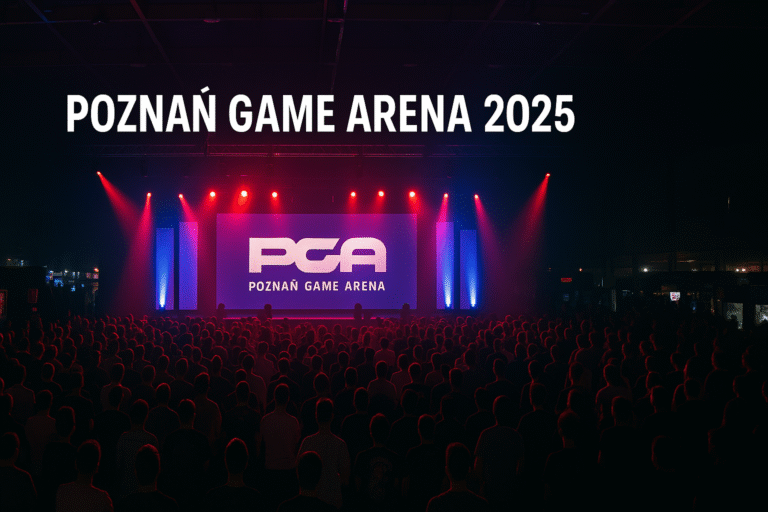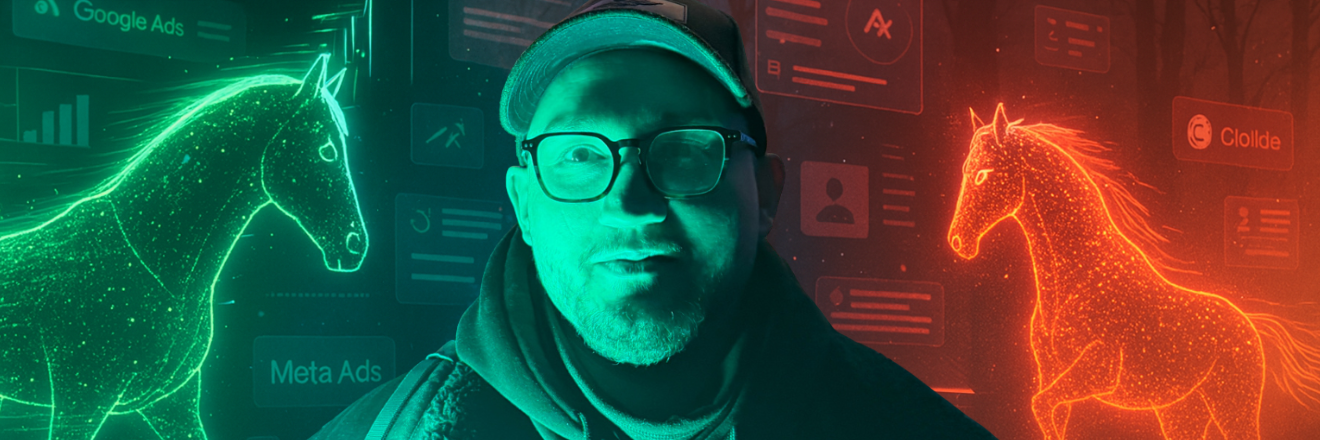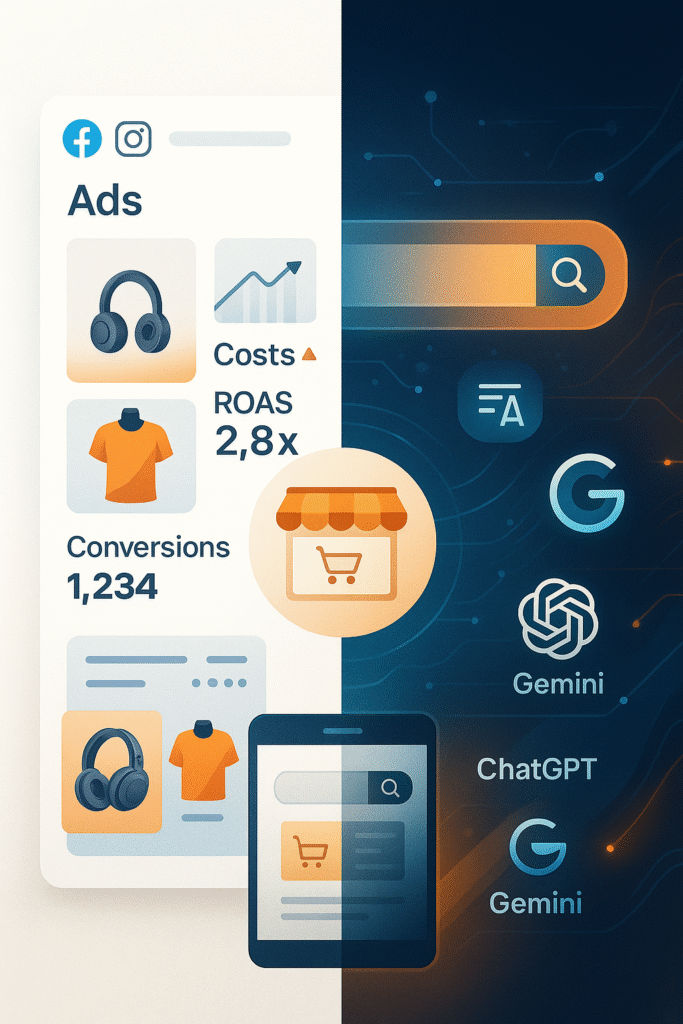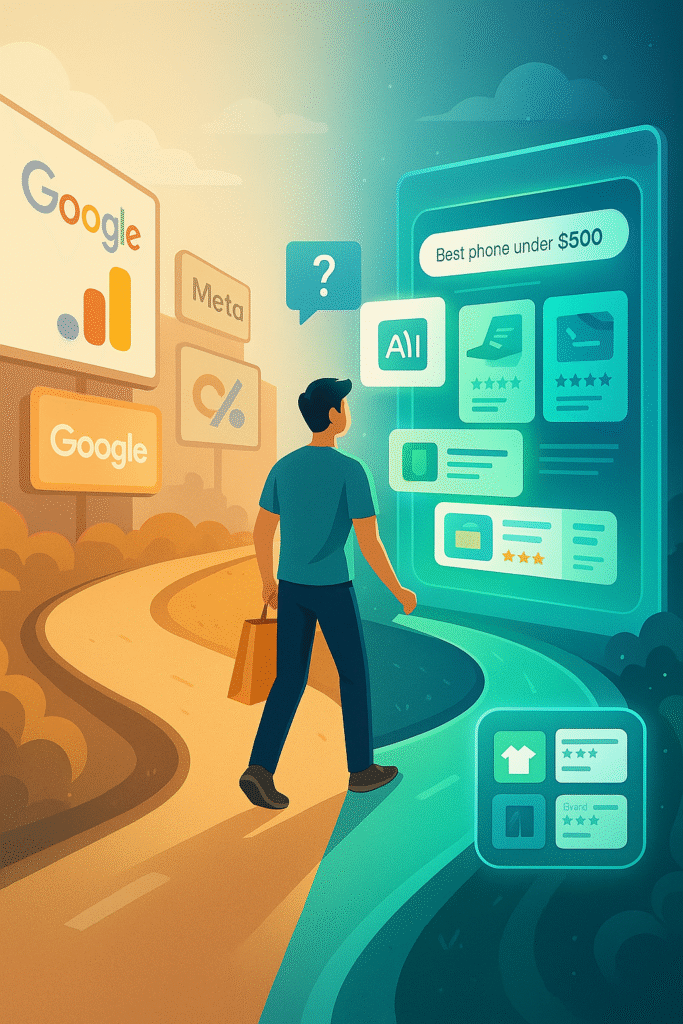1. Dual Strategy: Thriving in the Fragmented AI Marketing Landscape
In the coming years, the winner won’t be the one who bets on a single horse. Victory will go to those who can skillfully diversify both their campaign budgets and their creative and structural efforts—adapting to the next era of marketing with agility.
As Marshal Józef Piłsudski famously said, you must learn to sit on two chairs at once. In our context, one of those “chairs” is mastering campaign performance on platforms like Meta and Google Ads—improving creative quality and optimization. The other is embracing a multi-AI approach, learning how to build strategies not around a single large language model (LLM), but across many: Gemini, AI Overview, ChatGPT, Grok, Claude, DeepSearch and more.
Now, when we add the fact that e-commerce is a massive, multifaceted ecosystem—spanning countless industries and formats—it becomes clear that the promise of a single, universal path to success is a myth.
Real, lasting success comes from an individualized, ever-evolving approach, especially in creating content that’s optimized for AI citation and visibility. This is far from a static phenomenon. Even just within 2025, we’re seeing rapid changes in how this new marketing reality is taking shape.
ChatGPT Check-Out, launched in the U.S. earlier this year, and AI Overview, already live in the EU, are just two examples of this ever-shifting puzzle. We’re witnessing a three-dimensional race—where not only the stakes and the competitors change constantly, but the rules themselves evolve mid-race.
2. Google Ads – steady performance, rising costs
Google Ads are still a core part of most marketing strategies.
Search, YouTube, Shopping campaigns — they still deliver results.
But not without a price.
Reports from 2024 show that the average cost per click has climbed by 6–10%, and the cost per customer is up another 8%. That might not sound dramatic, but at scale, it adds up quickly.
So what does that mean in practice?
Without clean data, well-structured product feeds, and a sharp eye on what’s really converting, Google Ads can easily go from a sales engine to a bottomless pit.
This isn’t about being present anymore — it’s about surgical precision.
(Source: Search Engine Land, 2025)
3. Meta Ads – still effective, but increasingly expensive
Just a few years ago, most e-commerce stores followed a simple formula:
Google – to capture people already searching for a product.
Facebook or Instagram – to inspire them or remind them to buy.
That formula still works.
But these days, it comes with a hefty price tag.
Recent data shows that the average return on Meta ads (how much you earn per $1 spent) is now around 2.8× – slightly better than last year.
Sounds great? Well, there’s a catch: the cost of showing those ads has jumped by 20–30%.
In practice, that means one thing: Meta still drives sales, but to make it truly work, you need stronger creatives, sharper targeting, and constant testing.
It’s no longer a one-leg shuffle — it’s a full-time choreography.
(Source: Triple Whale, 2025)
4. The Rise of AI Search – A New Era of Product Discovery
As ad costs keep rising, a new way of finding products is quietly taking over: AI-driven search.
Fewer people are typing “best winter jacket” into Google.
Instead, they’re asking ChatGPT or using Google’s AI Overviews — and getting answers with side-by-side comparisons, brand suggestions, and direct links.
During the 2024 holiday season, traffic from AI chat tools jumped over 1,200% year over year.
(Source: Adobe Analytics, 2025)
At the same time, many websites saw a 30–50% drop in organic traffic from traditional search results.
(Source: NY Post, 2025)
The takeaway?
A growing part of the customer journey is now happening inside AI assistants — long before someone even lands on your website.
If you’re not showing up there — you simply don’t exist.
5. Why This Shift Favors AI-Driven Content
As ad prices keep climbing, both brands and shoppers are looking for simpler, faster, and cheaper ways to connect.
And AI fits that role perfectly — it answers instantly, suggests options, and often bypasses traditional ads altogether.
For now:
Google and Meta still dominate when it comes to closing the sale.
But it’s AI search that’s taking over the starting point — asking, exploring, comparing.
And here’s the real issue:
If your brand isn’t showing up in those first AI-generated answers — someone else’s will.
It’s that simple.

6. How Zen Spotlight Help
At Zen Spotlight, we help businesses navigate and win in this new landscape.
- We analyze your market, your competitors, and your audience from multiple angles. Levels I-III: Strategic Audit of Advertising Campaigns
- We begin by understanding and aligning with your brand’s core values — that’s the compass for everything that follows.
Levels I-III: Strategic Audit of Advertising Campaigns - We optimize your Google and Meta ad campaigns to get the most from every click.
Levels I-III: Strategic Audit of Advertising Campaigns - We build campaigns from scratch — from concept and structure to execution.
Level IV–VI: Implementation, Testing, Training - We deliver onsite training for your creative teams, so they can confidently produce AI-ready content. We optimize your Google and Meta ad campaigns to get the most value from every click.
Levels IV–VI: Implementation, Testing, Training - We run A/B tests to validate what truly works before scaling up.
Levels IV–VI: Implementation, Testing, Training - We create AI-friendly content — product pages, blog posts, and FAQs that tools like ChatGPT or Gemini can understand and cite.
Author’s post + promotion - We develop AI search strategies to ensure your brand appears right where product conversations begin.
Author’s post + YouTube + advertising campaign
We start with insight. Then we build. Then we scale.
The goal?
More conversions, lower costs, and visibility where today’s buying decisions are really being made.
Vist also About us

7. Summary
Paid ads still work — but every click costs more.
AI search is changing how people discover and trust brands.
The smart move isn’t to pick one side — it’s to ride both:
→ Meta & Google Ads for fast action
→ AI presence for early discovery and long-term trust
At Zen Spotlight, we help you combine both worlds —
so your brand grows while the rules keep changing.
8. Why This Matters in 2025
- Meta Ads still bring strong returns — ~2.8× on average —
but the cost of impressions (CPM) keeps climbing: +20–30% YoY. - Google Ads are stable but also rising in cost —
average CPC up 6–10% in the past year. - AI search is exploding — in 2024 alone,
traffic from tools like ChatGPT and Gemini grew over 1,200%.
The path to purchase has split:
- AI chat tools handle exploration and comparison
- Paid ads close the sale
Brands need both:
Performance marketing + AI-friendly content
10. About the Author
Daniel Słodkiewicz is a certified performance marketing strategist and the founder of Zen Spotlight — a boutique digital growth studio helping brands thrive in the age of AI and paid media.
With official certifications in Google Ads Measurement and Conversion Optimization, Daniel specializes in building full-funnel strategies that combine high-performance ad campaigns with AI-driven content visibility.
He works closely with businesses to:
- Audit and optimize Meta & Google Ads for maximum ROI
- Build campaigns from scratch with solid creative and data structure
- Create AI-ready content that gets cited in tools like ChatGPT, Gemini & Claude
- Run A/B tests to validate what works before scaling
- Deliver onsite training to empower creative teams and in-house marketers
Daniel’s approach is always grounded in research: he dives deep into your brand values, market landscape, and competitors before recommending any tactical moves. The result? Campaigns that convert, adapt, and stand out in a rapidly changing digital world.












